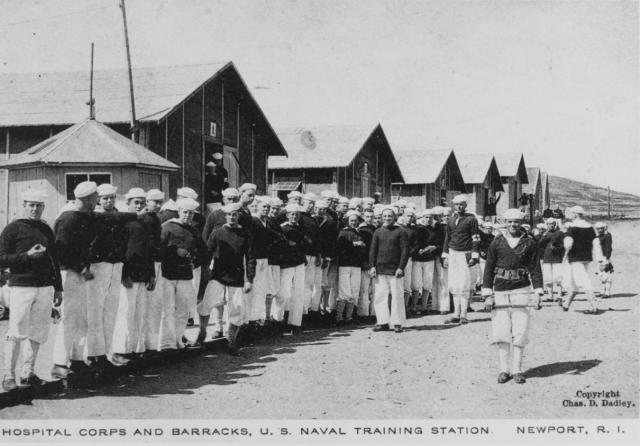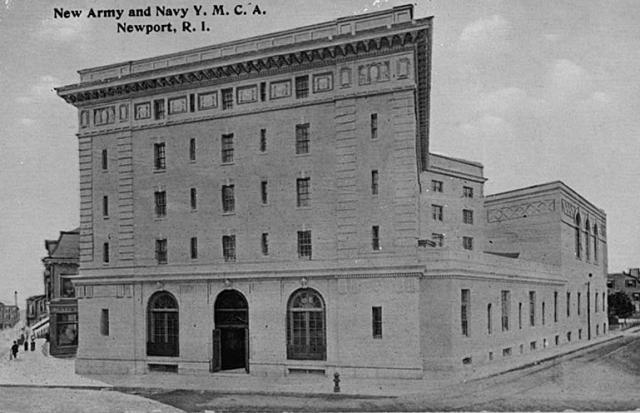In February 1919, Chief Machinist’s Mate Ervin Arnold found himself stationed at the Newport Naval Training Station in Newport, Rhode Island. Then a 14-year veteran with the U.S. Navy, and around 40, Arnold previously had worked as a detective in his home state of Connecticut for nearly nine years. On his arrival to Newport, Arnold was sent almost directly to the hospital, as he was struggling with a rather severe bout of rheumatism that required frequent medical attention. Not long after arriving, the machinist’s mate became somewhat friendly with his significantly younger fellow sailors, and their conversations eventually turned toward the general social climate many sailors enjoyed throughout the city of Newport. Unbeknown to all involved, these conversations would be the catalyst of a new, consuming obsession for Arnold: eradicating homosexuality from Newport and the U.S. Navy at large.
On his admission to the hospital, Arnold had begun to hear whispers of a kind of underground subculture that appeared to be thriving around him. It was a world of drinking, partying, and drug consumption, none of which was unfamiliar to sailors stationed in urban centers. What caught Arnold’s attention were mentions of cross-dressing, the exchange of sexual favors, and, worst of all in Arnold’s mind, sodomy. One sailor he met in the hospital, Thomas Brunelle, revealed that he was an active participant in this scene. Brunelle revealed the names of a handful of other individuals known to frequent these events, including a hospital corpsman, a local librarian, and even an Episcopal chaplain. Some of the men known to Brunelle would show up to these events donned in women’s clothing, taking up women’s names to refer to themselves among their inner-circles.
At the time, cross-dressing was not an unfamiliar practice among servicemen. It was not unheard of for sailors to dress as female characters in putting on theatrical performances during recreational hours for the enjoyment of their peers, a practice seen in the performing arts throughout history and around the world. In fact, these kinds of performances were even put on at the Newport Naval Training Station itself, and many of the performers involved were frequent fliers in these underground social circles. Sailors also were known to dress in drag during line-crossing ceremonies, a rite of passage for sailors who were crossing the equator for the first time. Even then, the social lives of Brunelle and his friends held Arnold’s mind captive. Thus begun his obsession with the group of men who often referred to themselves as “The Ladies of Newport.”
Arnold learned that these activities usually were centered around the local Army and Navy YMCA, and with this information he decided to report the men to a representative at the station’s welfare officer, Lieutenant Erastus Hudson. After the two reported the Ladies of Newport to the station’s commander, a court of inquiry was convened to investigate. The green light for the investigation officially was approved by then-Assistant Secretary to the Navy Franklin Roosevelt, who was acting on behalf of Secretary of the Navy Josephus Daniels.
Even though this matter was continually being passed up the ladder, Arnold could not let it go. Citing his past as a detective, he was able to convince his superiors he was a perfect fit to lead the investigation and going undercover to infiltrate the group was the only way. With the approval of his superior officers, Arnold sought out enlisted men who would be willing to go undercover at some of the events put on by Newport’s hidden gay community. He specifically looked for young, handsome sailors who he thought could draw the attention of the gay men he was hoping to target. The men of Arnold’s new task force were to linger around the YMCA and a handful of other local spots known to be popular among the gay community. By going on dates, walks, and attending parties within the community, Arnold was able to compile files on the Navy personnel, as well as any civilian participants, involved in these then-illicit sexual encounters. By mid-March, Arnold had enough damning information on these men to begin arresting them one-by-one.
By May 1919, 15 sailors were arrested for alleged homosexual conduct. Many were imprisoned, many were dishonorably discharged, while some were lucky enough to be released. Despite these results, Arnold and his task force insisted their work was not done, and Roosevelt agreed. Roosevelt gave his permission and financial support to Arnold and his team to widen their efforts to encompass any civilians found to be participating in Newport’s underground gay community. As such, he set his sights on Reverend Samuel Neal Kent, a well-respected Episcopal minister and beloved member of the Newport community. It was this decision that drew national attention and widespread condemnation of the Navy for the use of entrapment, in addition to allowing sailors as young as 17 to participate in sexual acts with adult men as part of the investigation.
Kent was tried twice. As a result of the investigation, he was found innocent twice. The public, members of the Senate, and especially clergymen in the Newport area were enraged by the tactics used in the Newport investigations. Indeed, a subcommittee of the Senate Committee on Naval Affairs publicly condemned both Roosevelt and Daniels for their roles in the Newport investigations, noting that the rights of both U.S. citizens as well as Navy enlisted men were violated in the process.
While Roosevelt’s negligent role in what is now known as the Newport Sex Scandal quickly faded into history, the investigations that took place in Newport fall into a broader narrative of unethical techniques used to single out and persecute LGBTQ+ individuals. The use of entrapment, identifying hotspots in the gay community, and going undercover to earn their trust, was widespread in the early-to-mid 20th century. It was investigations such as this one that eventually resulted in the birth of the modern gay rights movement, beginning with the Stonewall Riots in Greenwich Village in June 1969.






